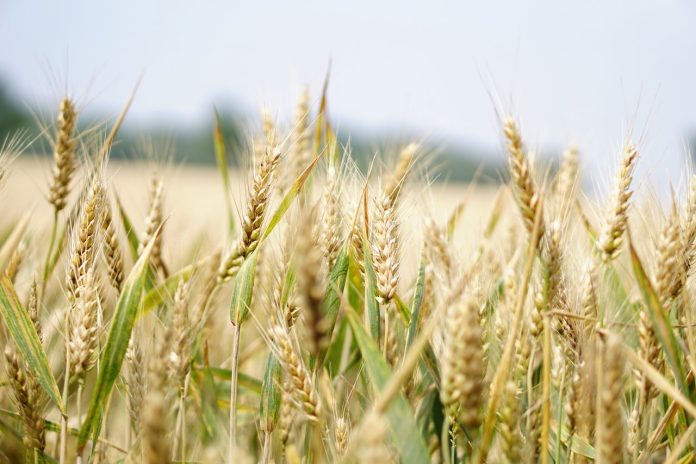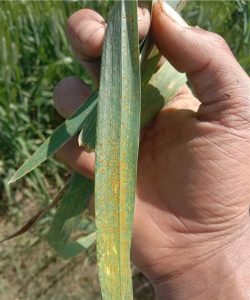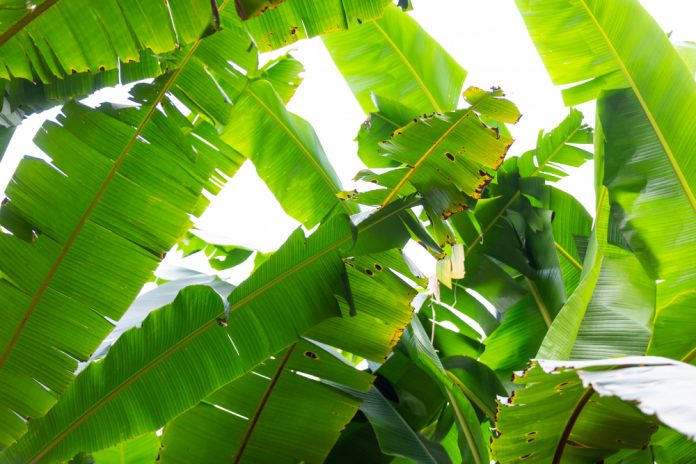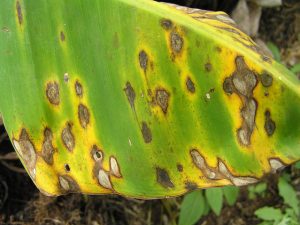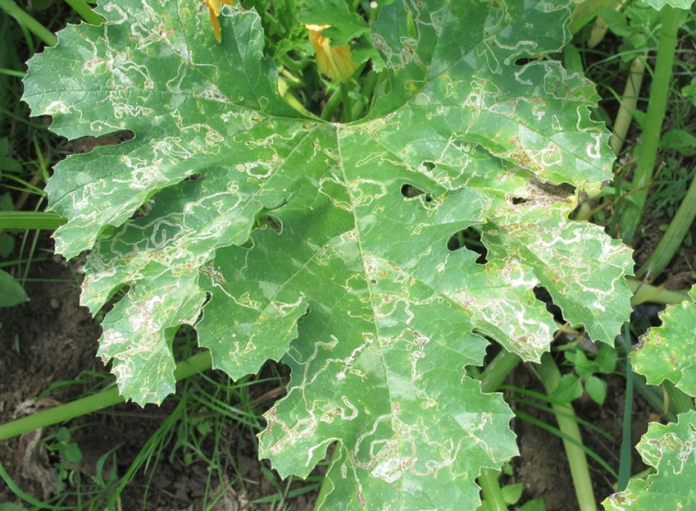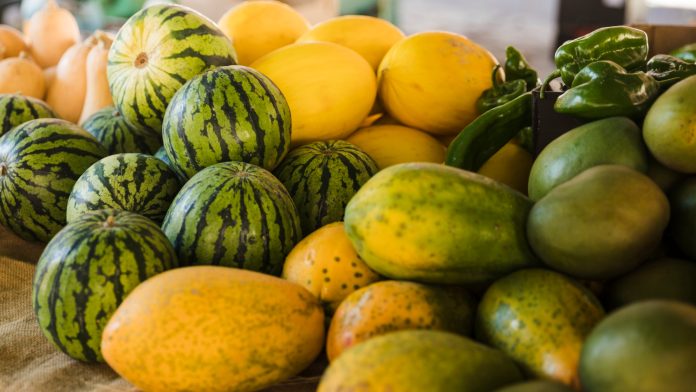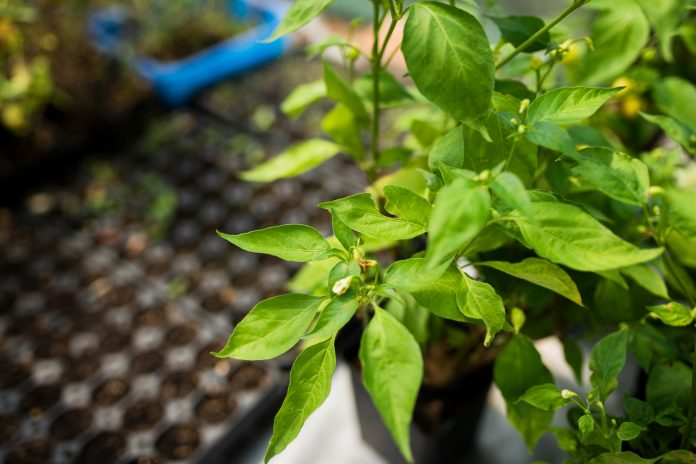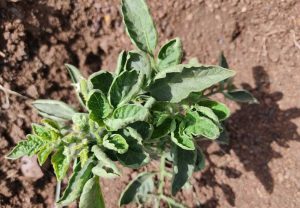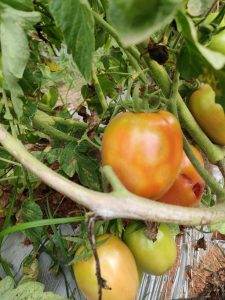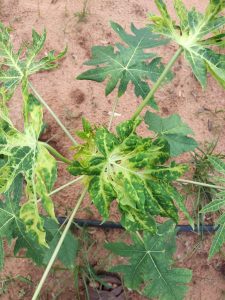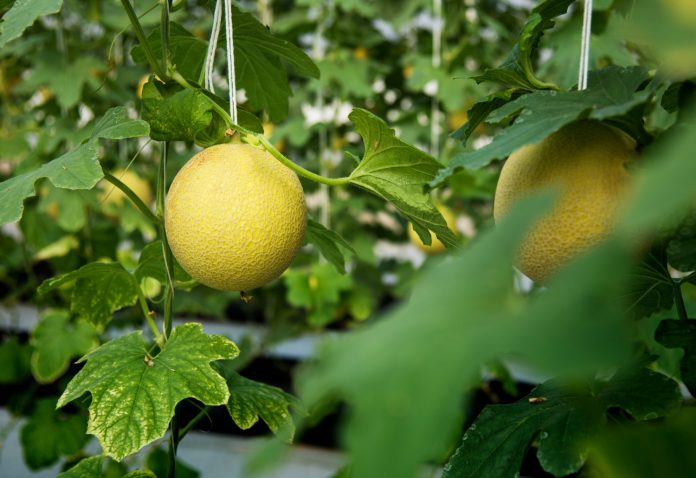Watermelon, scientifically known as Citrullus lanatus, belongs to the family Cucurbitaceae which includes other plants such as cucumber, squash and pumpkin. The watermelon plant is a vine-like plant that is typically grown in warm, tropical or subtropical climates. The fruit is dominant during summer season especially due to its high-water content and delicious taste. Major watermelon producing states in India includes Uttar Pradesh, Andhra Pradesh, Tamil Nadu, Karnataka and Orissa. Watermelon crops are susceptible to a variety of pests that can cause significant damage to the plants and reduce the overall yield of the crop.
Common insect pests affecting watermelon crops are discussed here;
-
Red Pumpkin Beetle
Scientific name: Aulacophora foveicollis
Pest stage of attack: Larva and adult
Stage of occurrence: Seedling/Vegetative stage
Identification of Symptoms
- Complete destruction of seedling due to adult feeding
- Leaves show riddled holes or notches due to beetle infestation leading to complete defoliation
- Larvae feed on roots and stems causing rotting and withering
- The beetles may also feed on the fruits, causing scars or holes, which can lead to rotting or sunburned spots on the fruit
- The undersurface of the fruits touching the soil surface will have larval tunnels in the surface.
Management of Red Pumpkin Beetle in Watermelon
| Product Name | Technical content | Dosage |
| Mechanical Management | ||
| Barrix Magic Sticker Chromatic trap yellow sheet | Chromatic trap | 10 sheets/acre |
| Biological Management | ||
| Multiplex Metarhizium Insecticide | Metarhizium anisopliae | 10 gm/lit water |
| Katyayani Neem Oil | Activated neem oil | 5 ml/lit water |
| Chemical Management | ||
| Polytrin C 44 EC Insecticide | Profenofos 40% + Cypermethrin 4% EC | 2 ml/lit water |
| Tafgor Insecticide or | Dimethoate 30% SC | 2 ml/lit water |
| Rogor Insecticide | 2 ml/lit water | |
| Katyayani Acepro Insecticide | Acetamiprid 20% SP | 0.5 gm/lit water |
| Ampligo Insecticide | Chlorantraniliprole (10 %) + Lambdacyhalothrin (5%) ZC | 0.5 ml/lit water |
-
Fruit fly
Scientific name: Bactrocera cucurbitae
Pest stage of attack: Maggots
Stage of occurrence: Fruiting stage
Identification of Symptoms
- The female fruit fly lays eggs under the skin of the fruit, which causes small puncture marks on the surface of the watermelon
- After the eggs hatch, the larvae burrow into the fruit and feed on the flesh, contaminating it with frass excreta, thus making it susceptible to secondary infections by fungi and bacteria
- The damage caused by the fruit flies can cause rotting and premature dropping of fruits
- Infected fruits become distorted and malformed.
Management of Fruit fly in Watermelon
| Product Name | Technical content | Dosage |
| Mechanical Management | ||
| Tapas fruit fly trap | Pheromone lure | 6 – 8 per acre |
| Entrap cucurbit fruit fly trap | Trap | 5 – 7 traps/acre for low fruit fly infestation area
7- 10 traps/acre for high fruit fly infestation area |
| Biological Management | ||
| Econeem Plus | Azadiractin 10000 PPM | 3 ml/lit water |
| Chemical Management | ||
| Coragen Insecticide | Chlorantraniliprole 18.5% SC | 0.3 ml/lit |
| Decis 2.8 EC Insecticide | Deltamethrin 2.8 EC | 1.5 – 2 ml/lit water |
| Polytrin C 44 EC Insecticide | Profenofos 40% + Cypermethrin 4% EC | 2 ml/lit water |
| Alika Insecticide | Thiamethoxam 12.6% + Lambda-cyhalothrin 9.5% ZC | 0.5 ml/lit water |
| BACF Endtask Insecticide | Fipronil 40% + Imidacloprid 40% WDG | 0.5 gm/lit water |
-
Thrips
Scientific name: Thrips tabaci
Pest stage of attack: Larva and adult
Stage of occurrence: Vegetative, flowering, fruiting stage
Identification of Symptoms
- Thrips feed on the leaf surface and suck the plant juice causing small, silvery white or stippling spots on the leaves
- Under severe infestation, the leaves turn yellow, wither and become deformed. This can lead to reduced plant growth and yield
- They may feed on the flowers of the plant, causing them to drop prematurely, which can reduce the number of fruit that the plant produces
- Thrips may also feed on the watermelon fruits causing scarred or distorted fruit.
Management of Thrips in Watermelon
| Product Name | Technical content | Dosage |
| Mechanical Management | ||
| Tapas Yellow Sticky Trap | 22 cm x 28 cm | 6 – 8/acre |
| Biological Management | ||
| Pesto Raze Bio-insecticide | Botanical Extracts | 2 ml/lit water |
| Control TRM Bio-pesticide | Organic blend of botanical extracts | 2 ml/lit water |
| Econeem Plus | Azadiractin 10000 ppm | 2 ml/lit water |
| Chemical Management | ||
| Benevia Insecticide | Cyantraniliprole 10.26% OD | 1.7 – 2 ml/lit water |
| Police Insecticide | Fipronil 40% + Imidacloprid 40% WG | 0.3 gm/lit water |
| Meothrin Insecticide | Fenpropathrin 30% EC | 0.5 ml/lit water |
| Caper Insecticide | Thiamethoxam 25%WG | 0.3 gm/lit water |
| Confidor Insecticide | Imidacloprid 17.8% SL | 0.75 ml/lit water |
| Lancer gold Insecticide | Acephate 50 % + Imidacloprid 1.8 % SP | 2 gm/lit water |
| Osheen Insecticide | Dinotefuran 20 % SG | 0.3 gm/lit water |
| Jump Insecticide | Fipronil 80% WG | 0.3 gm/lit water |
-
Aphids
Scientific name: Peach aphid – Myzus persicae; Melon aphid – Aphis gossypii
Pest stage of attack: Nymph and adult
Stage of occurrence: Seedling, Vegetative, flowering
Vector: Watermelon Mosaic Virus
Identification of Symptoms
- Small, pear-shaped, soft bodies insects can be found on leaves or stems of the plant
- Aphids’ feeds on the tender shoots and under surface of the leaves by sucking the leaf sap causing curling and crinkling of the leaves
- They secrete a sticky, sugary substance called honeydew, which causes black sooty mould development that accumulates on the leaves and attracts other insects, such as ants
- This also reduces the photosynthetic activity leading to stunted growth.
Management of Aphids in Watermelon
| Product Name | Technical content | Dosage |
| Mechanical Management | ||
| Tapas Yellow Sticky Trap | 11 cm x 28 cm | 4 – 6/acre |
| Biological Management | ||
| Amruth Alestra Liquid | Verticillium lecanii | 2 ml/lit water |
| Ecotin Insecticide | Azadirachtin 5% EC | 0.5 ml/lit water |
| Chemical Management | ||
| Polytrin C 44 EC Insecticide
|
40% (Profenofos) + 4% (Cypermethrin) EC | 2 ml/lit water |
| Omite Insecticide | Propargite 57% EC | 1.5 – 2.5 ml/lit water |
| Keefun Insecticide | Tolfenpyrad 15% EC | 2 ml/lit water |
| Alika Insecticide | Thiamethoxam 12.6% + Lambda-cyhalothrin 9.5% ZC | 0.5 ml/lit water |
| Areva Insecticide | Thiamethoxam 25% WG | 0.3 gm/lit water |
| Tatamida SL Insecticide | Imidacloprid 17.8% SL | 1 ml/lit water |
| Osheen Insecticide | Dinotefuran 20 % SG | 0.3 gm/lit water |
| Ulala Insecticide | Flonicamid 50 WG | 0.3 gm/lit water |
-
Whitefly
Scientific name: Bemisia tabaci
Pest stage of attack: Nymph and adult
Stage of occurrence: Vegetative, flowering stage
Vector: Watermelon leaf curl virus
Identification of Symptoms
- Feeding activity of nymph and adult may lead to yellowing, downward curling and drying of leaves
- They also cause sooty mould development due to honeydew secretion causing restricted photosynthesis
- It can cause the leaves to turn yellow (chlorotic spots) and fall off prematurely
- Affected leaves may become deformed.
Management of Whitefly in Watermelon
| Product Name | Technical Content | Dosage |
| Mechanical Management | ||
| Tapas Yellow Sticky Trap | 11 cm x 28 cm | 4 – 6/acre |
| Biological Management | ||
| Amruth Alestra Liquid | Verticillium lecanii | 2 ml/lit water |
| T.Stanes Nimbecidine | Azardiractin 300 PPM (EC formulation) | 5-10 ml/lit water |
| Chemical Management | ||
| Tychi Insecticide | Tolfenpyrad 15% EC | 2 ml/lit water |
| Oberon Insecticide | Spiromesifen 22.9 % SC | 0.3 ml/lit water |
| Pager Insecticide | Diafenthiuron 50% WP | 1.2 gm/lit water |
| Ulala Insecticide | Flonicamid 50 WG | 0.3 gm/lit water |
| Actara Insecticide | Thiamethoxam 25 % WG | 0.5 gm/lit water |
| Tatamida SL Insecticide | Imidacloprid 17.8% SL | 1-2ml/lit water |
| Kaitaku Insecticide | Acetamiprid 20 % SP | 0.1 – 0.2 ml/lit |
-
Leaf eating caterpillar
Scientific name: Diaphania indica
Pest stage of attack: Larva
Stage of occurrence: Vegetative stage
Identification of Symptoms
- Caterpillars feed on the young and tender leaves of watermelon plants, which can result in holes and ragged edges on the leaves
- They fold the leaves and scrape the epidermal layer of leaves causing skeletonization of the leaves, where only the veins of the leaf remain intact
- Under severe infestation, it can cause defoliation of leaves, thus reducing plant growth and vigor, resulting in smaller plants and fruit.
Management of Leaf eating caterpillar in Watermelon
| Product Name | Technical content | Dosage |
| Biological Management | ||
| Anshul Bio Finish (Bio Pesticide) | Plant extracts | 3 – 5 ml/lit water |
| Amruth Alnym Bio Pesticide | Azadirachtin 0.15% – 1500 ppm | |
| Chemical Management | ||
| Coragen Insecticide | Chlorantraniliprole 18.5% SC | 0.3 ml/lit water |
| Jashn Super Insecticide | Profenofos 40% + Cypermethrin 4% EC | 2 ml/lit water |
| Zapac Insecticide | Thiamethoxam 12.6% + Lambda Cyhalothrin 9.5% ZC | 0.3 ml/lit water |
| Plethora Insecticide | Novaluron 5.25% + Indoxacarb 4.5% w/w SC | 2 ml/lit water |
| Rilon Insecticide | Emamectin benzonate 5% SG | 0.5 gm/lit water |
-
Serpentine Leaf Miner
Scientific name: Liriomyza trifolli
Pest stage of attack: Larva
Stage of occurrence: Vegetative, flowering and fruiting stage
Identification of Symptoms
- Serpentine leaf miners create winding, snake-like tunnels on the leaves as they feed on the leaf tissue
- It can cause the infested leaves to turn yellow or brown
- Under severe infestation, these leaves dry and drop off from the plant
- It may lead to stunted growth of the plant and reduce the overall plant vigour
- The larva sometimes tunnels through the rind of the fruit, causing scars and reducing the fruit’s quality and marketability.
Management of Serpentine Leaf Miner in Watermelon
| Product Name | Technical Name | Dosage |
| Mechanical Management | ||
| Tapas Yellow Sticky Trap | 11 cm x 28 cm | 4 – 6/acre |
| Barrix magic sticker chromatic trap blue sheet | Chromatic trap | 8 sheets/acre |
| Biological Management | ||
| Terra might | Herbal formulation | 3 – 7 ml/lit water |
| Eco neem plus | Azadiractin 10000 PPM | 1.6 – 2.4 ml/lit water |
| Sun Bio beviguard | Beauveria bassiana / brongniartii | 5 ml/lit water |
| Nanobee Agrokill Insecticide | Nano Colloidal Micelles 100% (Fatty Acid based Plant Extracts) | 3 ml/lit water |
| Chemical Management | ||
| Benevia Insecticide | Cyantraniliprole 10.26% OD | 1.7 – 2 ml/lit water |
| Ekalux Insecticide | Quinalphos 25 % EC | 2 ml/lit water |
| Confidor Insecticide | Imidacloprid 17.8% SL | 0.75 to 1 ml/lit water |
| Police Insecticide | Fipronil 40% + Imidacloprid 40% WG | 0.2 – 0.6 gm/lit water |
| Sivanto Bayer Insecticide | Flupyradifurone 17.09% SL | 2 ml/lit water |
| Katyayani Acepro Insecticide | Acetamiprid 20% SP | 0.5 gm/lit water |
-
Red Spider Mite
Scientific name: Tetranychus urticae
Pest stage of attack: Adult
Stage of occurrence: Vegetative, flowering and fruiting stage
Identification of Symptoms
- Red spider mites using their long, needle like mouthpart, suck the chlorophyll content in the leaves and causes chlorosis
- They feed on the underside of leaves, which can result in stippling or small yellow or white dots on the upper surface of the leaves
- They often produce fine webbing on the leaf surface
- Affected leaves completely dry and drop off.
Management of Red Spider Mite in Watermelon
| Product name | Technical content | Dosage |
| Biological Management | ||
| Royal Clear Mite | 100% derived from plant extracts | 2 ml/lit water |
| R Mite Bio Acaricide | Plant extracts | 1 – 2 ml/ lit water |
| PerfoMite | Phyto-extracts – 30%, Enzyme extracts – 5%, Chitin Dissolvers | 2 ml / 1 lit water |
| Chemical Management | ||
| Oberon Insecticide | Spiromesifen 22.9% SC | 0.3 ml /lit water |
| Abacin Insecticide | Abamectin 1.9% EC | 0.7 ml /lit water |
| Maiden Insecticide | Hexythiazox 5.45% EC | 1 ml /lit water |
| Intrepid insecticide | Chlorfenapyr 10% SC | 2 ml/lit water |
| Danitol Insecticide | Fenpropathrin 10% EC | 1.5 ml/lit water |
| Movento Energy | Spirotetramat 11.01% + Imidacloprid 11.01% SC | 0.5 – 1 ml/lit water |
-
Cutworms
Scientific name: Agrotis spp, Peridroma saucia, Nephelodes minians, Spodoptera litura
Pest stage of attack: Larva
Stage of occurrence: Seedling stage
Identification of Symptoms
- Cutworms often feed on the stems of young watermelon plants, cutting them at or near the soil line. This can cause the plant to wilt or die
- They feed on the leaves, causing irregular holes or notches in the foliage
- They are nocturnal and may not be visible during the day, but emerge at night, by burrowing in the soil near the base of the plant.
Management of Cutworms in Watermelon
| Product name | Technical content | Dosage |
| Mechanical Management | ||
| Tapas Tobacco Caterpillar Lure | Pheromone lure | Funnel trap with Spodo-O-lure at 6/acre |
| Biological Management | ||
| Katyayani BT Bio Larvicide | Bacillus thuringiensis | 10 ml/lit water |
| Dr.Bacto’s Brave | Beauveria bassiana | 2.5 ml/lit water |
| Chemical Management | ||
| Proclaim Insecticide or | Emamectin Benzonate 5% SG | 0.4 gm/lit water |
| Starclaim Insecticide | 0.5 gm/lit water | |
| Tracer Insecticide | Spinosad 44.03% SC | 0.3 ml/lit water |
| Ampligo Insecticide
|
Chlorantraniliprole 10% + Lambda cyhalothrin 5% ZC | 0.5 ml/lit water |
| Hamla 550 | Chlorpyriphos 50% + Cypermethrin 5% EC | 2 ml/lit water |
| Meothrin Insecticide | Fenpropathrin 30% EC | 0.5 ml/lit water |
-
Cucumber Beetle
Scientific name: Diabrotica spp
Attacking stage of pest – Larva and adult
Stage of occurrence – Vegetative, flowering and fruiting stage
Vector – Bacterial wilt disease
Identification of Symptoms
- Larvae feed on the roots of the plants, causing wilting and stunting
- Adult cucumber beetles feed on the foliage of watermelon plants, causing defoliation and thus reduces photosynthesis.
- They feed on the surface of the watermelon fruit, leaving shallow, irregularly shaped scars on the rind. This type of cosmetic damage may not affect the quality of the fruit, but it can reduce its marketability.
Management of Cucumber Beetle in Watermelon
| Product name | Technical content | Dosage |
| Biological Management | ||
| Econeem Azadirachtin 3000 PPM | Azadirachtin 0.3% EC | 2.5 – 3 ml/lit water |
| Chemical Management | ||
| Karate Insecticide | Lambdacyhalothrin 5% EC | 1.5 – 1.65 ml/lit water |
| Danitol Insecticide | Fenpropathrin 10% EC | 1.5 – 2 ml/lit water |
| Anshul Ikon Insecticide | Acetamiprid 20% SP | 0.5 gm/lit water |
NOTE:
- Refer to the product label to find the right time of application and more details of the product.
- It is advised to spray Bio-fungicides during early morning or evening hours when the temperature is relatively cool to get best results.
Conclusion
Insect pests can affect watermelon plants at any stage of growth, from seedlings to mature plants and can cause damage to the leaves, stems and fruit. This can result in reduced plant growth, decreased fruit quality and size and in severe cases, even plant death. Effective pest management strategies, such as regular monitoring, good agronomic practices and the use of chemical and biological control methods, can help in controlling the pest damage, protect the yield and quality of watermelon crops.


